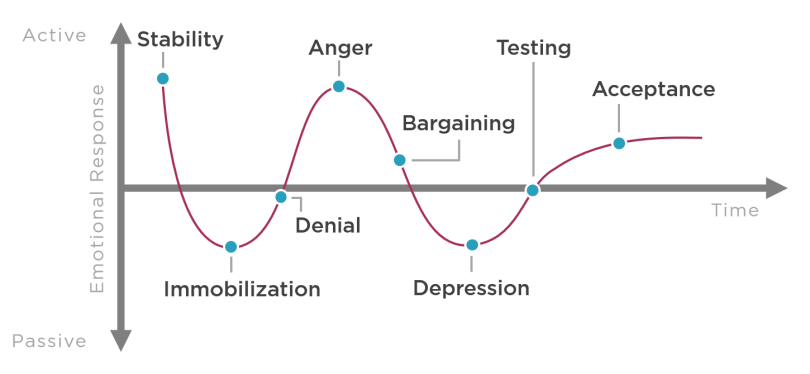As a leader in your organization, you are an integral part of the overall change journey for your team. Leading change can be challenging, and I want to help you build your organizational change-management muscles.
Change brings out many emotions in people, and while some will be excited, many will have anxiety about the shift. Everyone is different. Reaction to change is likely to be emotional rather than rational, and past experiences will influence the current situation. Understanding this emotional curve will help you navigate change and assist others to do so as well.
In this series, you will learn about:
- Each phase of the change curve
- Statements you can expect to hear from others in each phase
- How to support people in each phase
- How to help move them to the next phase
Note: To see Kevin teach this series on video, check out his course, Managing IT: Organizational Change Management, on Pluralsight.
Explaining the Emotional Change Curve
The model above is a variation of Elizabeth Kübler-Ross’ now-famous grief cycle, published in 1969, describing how people react to catastrophic personal loss, according to a specific pattern of emotional responses and energy over time.

The y-axis on the left shows the two different emotional response energy types: active and passive. When someone is in a passive state, they are quieter and more reserved than usual. When someone is in an active state, they are more vocal and animated than usual.
The x-axis across the middle represents how someone would navigate through the stages over time in a perfect scenario. Though in practice, people can slip back to a previous stage if a proper response to their current stage is not given. Everyone’s timeline is unique, and while time spent in a phase may be brief, it is rare for people to skip a stage.
The 8 Emotions of Change
- Stability
- Immobilization
- Denial
- Anger
- Bargaining
- Depression
- Testing
- Acceptance
Before We Begin
Think about your past experiences with change. Write down a positive change you experienced, as well as a negative change. Write down all the emotions you felt during each while the changes were being implemented. Write down what was done well in the positive change that made it easier to accept and what was handled poorly in the negative change that made you resist. Refer back to these notes with each issue as we dive into the details of each phase.
Stability and Immobilization
To help someone move through one stage and into the next, it’s critical that you be able to recognize where they are in the moment. This is essential if you want the change in question to be adopted in a way that provides value to the organization — not to mention it makes you a better leader.
At the beginning of the change curve, people are stable. A majority are happy and are active in a positive way. When they hear about a large change, passive immobilization quickly takes effect as they try to make sense of the announcement (or even rumor) they just heard. This stage usually passes quickly, and they enter the denial stage, where they begin to become active again.
Denial
Some will choose to ignore the change and just continue doing things as they had previously, causing them to fall behind in understanding what the change is and why it is being done.
Some who feel they are currently in a bad situation and anything will be an improvement, even the unknown, will gladly welcome the change. While it is easy to think they are skipping the denial stage, theirs may manifest itself in a lack of trust that the change announced will actually occur.
The denial stage does not mean a lack of desire to change; it directly correlates to a disbelief that the change will be completed.
Common Phrases Heard in the Denial Stage
- “This will pass, just like all of the other fads that have come through here.”
- “This change is silly. The way we do things now is just fine.”
- “I’ll bet leadership abandons this change, just like how they abandoned the last change.”
- “I’ll believe it when I see it.”
How to Support Someone in the Denial Stage
- Do communicate what the change is, why it’s being made — and why now.
- Do provide additional resources, such as a website and/or contact person.
- Do follow up frequently with more information each time.
- Don't communicate too many details, as it can overwhelm someone just learning about the change and lead them to ignore future communication.
How to Help Someone Move on From Denial
- Be empathetic so people will share their fears and resentment.
- Put yourself in their shoes and really listen to them.
- Seek to understand why people are in the denial stage.
- Reinforce the change is going to happen.
Balance Empathy and Reinforcement
Finding a good balance between empathy and reinforcement is key. Assisting others through the change curve will take time — and it will always be more time than you anticipate.
Every change is different, and every person is different. You cannot schedule how quickly people move through the change curve, because other people’s emotions are out of your control. There is no silver bullet.
Putting It Into Practice
Look back on your notes, including the positive and negative changes from your past. For each of those changes, write down how long you think you were in the denial stage and who helped you exit it. Write down what was said or done to help you accept that the change was in fact happening.
Up next: We’ll tackle anger and bargaining.





